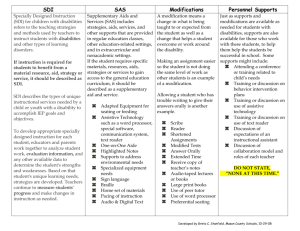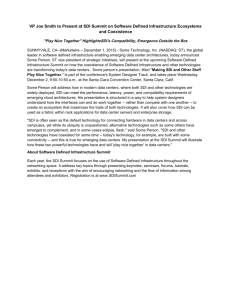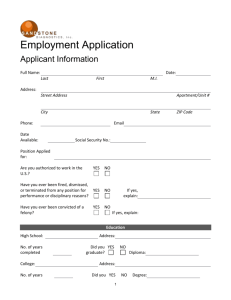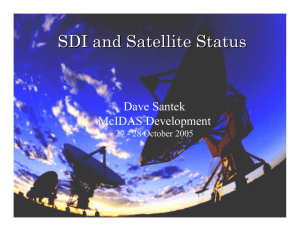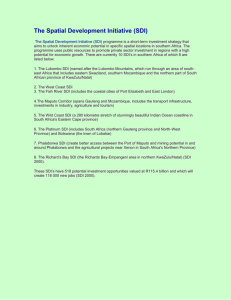The Production Economics of Managing Color Irrigation - A Case Study
advertisement
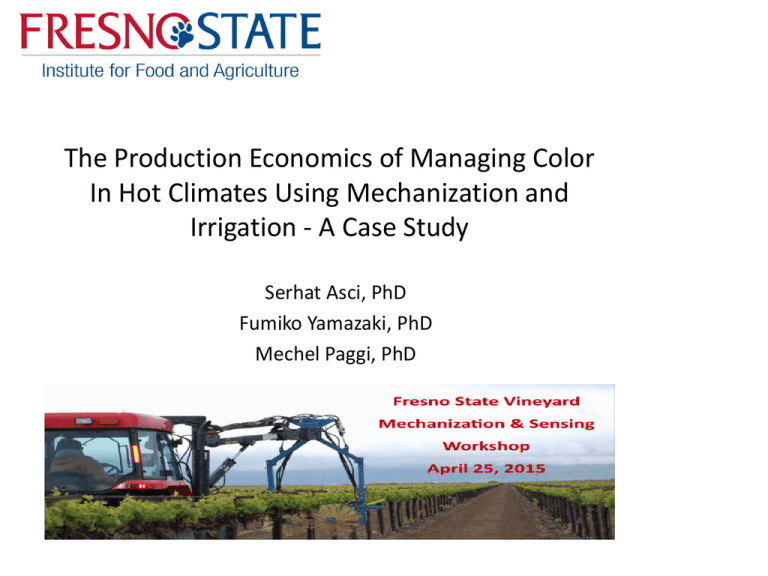
The Production Economics of Managing Color In Hot Climates Using Mechanization and Irrigation - A Case Study Serhat Asci, PhD Fumiko Yamazaki, PhD Mechel Paggi, PhD Objective • This study aims to construct an economic analysis of merlot production in San Joaquin Valley (SJV). • Four different scenarios are constructed for merlot production with various leaf removal and irrigation treatments in an experiment by the Viticulture and Enology Research Center (VERC) at California State University, Fresno. MOTIVATION • These treatments improves grape color compound (anthocyanin) both quantitatively and qualitatively. • Related with weather conditions, treatments increase cost and sometimes cause significant yield decrease compared to the base production scenario. • Thus, we provide information for a new price level (premium price) for each scenario so that the growers can improve the color by these treatments and might be able to compensate the negative weather impact. Merlot for Wine Production in California In 2014, • 2.8 MT merlot crushed in California (13% of red wine grapes crushed), – 35% of merlot grapes are crushed in SJV (993 thousand The Share of San Joaquin Valley's Merlot Crushed in California Tons). 45.0% 40.0% 35.0% 30.0% 25.0% 20.0% 15.0% 10.0% 5.0% 0.0% Source: Madera/Fresno County http://winegrapesdirect.com/?page_id=101 Source: California Grape Crush Reports (USDA, 2005-2014) Merlot Grower Returns in San Joaquin Valley vs. California In 2014, 70.0% – Average grower returns per ton60.0% 50.0% for merlot is $774.7/ton in 40.0% 30.0% California while it is only 20.0% 10.0% $374.8/ton in SJV. 0.0% Ratio of SJV' Grower Returns from Merlot to California Average Comparison of Average Degrees Brix for Merlot Grape Purchased for Wine Degrees Brix 25.5 25 24.5 24 23.5 23 San Joaquin Valley Source: http://www.winesandvines.com/ California Source: California Grape Crush Reports (USDA, 2005-2014) Grape COLOR and Prices – Studies find a strong positive correlation between wine grape color (anthocyanin concentration) and price (Webb 2006). – SJV is known with Low Anthocyanin accumulation. Source: Wine color app on iPad Experimental design - Case Study* • • • • Place: San Joaquin Valley of California Crop: Wine grape, Merlot Seasons: 2013 – 2014 (drought) Treatments: – Mechanical leaf removal • Control – no leaf removal • Leaf removal at Pre-bloom stage • Leaf removal at Post-fruit set – Irrigation treatment • Sustained deficit irrigation (SDI) • Regulated deficit irrigation (RDI) Source: http://www.fresnostatenews.com/ • Grapes are harvested at 24 ̊Brix * Please visit Kurtural et al. (2015) for more information about the experiment. Kurtural et al. (2015) Anthocyanin Composition of Merlot Grapevine is Ameliorated by Light Microclimate and Irrigation in Central California, American Journal of Enology and Viticulture, 66(3): forthcoming. Differences in SDI and RDI • Sustained deficit irrigation (SDI): • 0.8 ETc and -1.2 MPa from anthesis to harvest • Regulated deficit irrigation (RDI): • 0.8 ETc and -1.2 MPa from anthesis to fruit set • 0.5 ETc and -1.4 MPa from fruit set to veraison • 0.8 ETc and -1.2 MPa from veraison to harvest Significant Experiment Results - Yield • Leaf removal • The pre-bloom and post-fruit set leaf removal treatments reduced the berry skin mass by 6% and 18% in 2013 and 5% and 13% in 2014. • The berry mass and the cluster mass were reduced by approximately 7% and 13% by both pre-bloom and post-fruit set in 2013, respectively. • Irrigation Regime • RDI reduced the berry mass by 6% and 9% in 2013 and 2014, respectively, compared to SDI. • In 2014, RDI reduced the cluster mass and yield by approximately 13%, compared to SDI. Significant Experiment Results – Berry and anthocyanin composition • Brix: – Post-fruit set leaf removal decreased Brix by 3% when compared to both control and pre-bloom leaf removal in 2013. – RDI increased Brix by 2% and 2.5% in both 2013 and 2014, respectively, compared to SDI. • Color: – Anthocyanin analysis was conducted with the HPLC system. – In both years of the study the pre-bloom leaf removal treatment increased total skin anthocyanin (TSA) amount by 25% compared to control. The irrigation treatments did not affect TSA amount in either year. – Qualitative anthocyanin: Leaf removal did not affect them in either year. The SDI treatment increased them in both years when compared to RDI. – RDI develops stable color. * Please visit Kurtural et al. (2015) for more information about the results. Observations Summary Effects of mechanical leaf removal and fractions of crop evapotranspiration application on components of yield and yield efficiency of ‘Merlot 01/Freedom’ in northern San Joaquin Valley of California (n = 4). Berry mass(g) Leaf Removal Control Pre-bloom Post-fruit set Pr>F ETc fraction SDI RDI Pr>F LR x ETc fraction Leaf Removal Control Pre-bloom Post-fruit set Pr>F ETc fraction SDI RDI Pr>F LR x ETc fraction Berry skin mass(mg) Cluster mass(g) Yield (kg/m) 2013 TSS (%) Juice pH TA (g/L) 1.36 1.27 1.28 0.0216 55 51.7 45 0.002 167.7 147.4 143.5 0.0029 6.64 6.34 6.78 0.4996 24.6 24.7 24 0.0171 3.57 3.59 3.58 0.6783 5.26 4.78 5.06 0.0779 1.34 1.26 0.0068 0.9004 51.3 47.8 0.5103 0.9074 153.5 152.2 0.8379 0.5665 6.86 6.31 0.0748 0.8684 24.2 24.7 0.0206 0.8882 3.59 3.57 0.2531 0.7035 5.04 5.02 0.8853 0.7264 2014 1.09 1.07 1.11 0.5314 45.3 42.9 39.5 0.031 111.7 109.9 106.8 0.6426 6.17 6.1 4.46* 0.0016 24.3 24.1 24.2 0.7905 3.6 3.62 3.64 0.211 4.83 4.66 4.69 0.4152 1.14 1.04 0.0021 0.4878 42.7 42.3 0.6963 0.5892 116.4 102.3 0.0001 0.9943 6.08 5.27* 0.0003 0.0053 23.9 24.5 0.0199 0.6608 3.63 3.61 0.288 0.5241 4.83 4.62 0.0786 0.9698 * Significant difference in yield. Cost Items Associated with Treatments Pruning cost ($/ha) Irrigation water Leaf removal cost Irrigation applied cost ($/ha) (ML/ha) ($/ha) 2013 Control+SDI 748 0 2.37 950 Pre-bloom+SDI 748 30 2.37 950 Pre-bloom+RDI 748 30 2.03 827 Post-fruit set+SDI 748 30 2.37 950 Post-fruit set+RDI 748 30 2.03 827 2014 Control+SDI 748 0 3.08 1,235 Pre-bloom+SDI 748 30 3.08 1,235 Pre-bloom+RDI 748 30 2.6 1,029 Post-fruit set+SDI 748 30 3.08 1,235 Post-fruit set+RDI 748 30 2.6 1,029 * Effects of mechanical leaf removal and fractions of crop evapotranspiration application on labor operations cost of canopy management in northern San Joaquin Valley of California (n = 4). Baseline & Experiment Results 2013 • Control and SDI is taken as a base for merlot production in the valley. Probabilities that 2013 Net Income after Taxes per acre will be Less Than $900 and Greater Than $1,500 100% 0.10 • • • Irrigation Cost (SDI): $950/ha ($385/acre) Yield: 11.4 ton/acre Price: $443/ton • • No significant yield change in 2013. No need to increase price significantly to compensate the cost, yet experiments results show improvements in color components. 90% 80% 70% 0.36 60% 50% 40% 30% 0.54 20% 10% 0% Base + SDI Results – 2014 (1/5) • We observe the impact of drought severely in 2014 yield result. Probabilities that 2014 Net Income after Taxes per acre will be Less Than $900 and Greater Than $1,500 • 100% 0.09 90% 80% 70% 0.37 • • Irrigation Cost (SDI): $1235/ha ($500/acre) Yield: 10.0 ton/acre Price: $514.5/ton* 60% 50% • 40% 30% 0.54 20% 10% • 0% Base + SDI Yield decrease significantly in 2014 with post-fruit set leaf removal and RDI treatment. We will need to increase price to compensate the cost. * Note: Developed from referenced price of cabernet sauvignon in SVJ by using percentage difference in prices between cabernet sauvignon and merlot from the pricing district 13, Grape Crush Report Final 2014 (March 10, 2015). Results – 2014 (2/5) • Scenario 1: Pre-bloom + SDI Probabilities that 2014 Net Income after Taxes per acre will be Less Than $900 and Greater Than $1,500 100% 0.09 90% 80% 70% 0.37 60% • Irrigation Cost (SDI): $1235/ha ($500/acre) • Yield: 10.0 ton/acre • Cost increase: $30 extra cost for leaf removal. 50% 40% 30% 0.54 20% 10% 0% Scenario 1 (Pre-bloom + SDI) • New Price Level: $514.5/ton • TSA: Increase TSA by 25% and high in valuable anthocyanin. Results – 2014 (3/5) • Scenario 2: Pre-bloom + RDI Probabilities that 2014 Net Income after Taxes per acre will be Less Than $900 and Greater Than $1,500 Probabilities that 2014 Net Income after Taxes per acre will be Less Than $900 and Greater Than $1,500 100% 0.00 100% 0.09 90% 98% 80% 96% 94% 0.11 70% 0.36 60% 92% 50% 90% 40% 30% 88% 0.55 20% 86% 0.89 84% 10% 0% 82% Scenario 2 (Pre-bloom + RDI) Scenario 2 (Pre-bloom + RDI) Price increase by 15% Results – 2014 (4/5) • Scenario 3: Post-fruit set + SDI Probabilities that 2014 Net Income after Taxes per acre will be Less Than $900 and Greater Than $1,500 Probabilities that 2014 Net Income after Taxes per acre will be Less Than $900 and Greater Than $1,500 100% 0.00 100% 0.10 90% 90% 80% 80% 70% 70% 0.37 60% 60% 50% 50% 1.00 40% 40% 30% 0.53 30% 20% 20% 10% 10% 0% 0% Scenario 3 (Post-fruit set + SDI) Irrigation Cost (SDI): $1235/ha ($500/acre); Yield: 7.2 ton/acre Cost increase: $30 extra cost for leaf removal Scenario 3 (Post-fruit set + SDI) Price increase by 40% New Price Level: $720/ton TSA: High in valuable anthocyanin. Results – 2014 (5/5) • Scenario 4: Post-fruit set + RDI Probabilities that 2014 Net Income after Taxes per acre will be Less Than $900 and Greater Than $1,500 100% 0.08 90% 80% 70% 0.36 60% 50% 40% 30% • Irrigation Cost (RDI): $1029/ha ($416/acre) • Yield: 7.2 ton/acre • Cost increase: $30 extra cost for leaf removal 0.56 20% • New Price Level: $695/ton 10% 0% Scenario 4 (Post-fruit set + RDI) Price increase by 35% • TSA: insignificant increase in amount. More stable color and retain it. Conclusion • Leaf removal and deficit irrigation treatments improves the anthocyanin (color compounds) level of merlot grape. • However, these treatments have significantly negative impact on yield and grape’s mass content when the severity of drought is high. • The treatments will increase the negotiation power of growers and also improves the wine quality. • The new price levels should be studied well. Since, they only compensate the grower’s cost while it would open high value markets for wine processors. Serhat Asci sasci@csufresno.edu Fumiko Yamazaki fyamazaki@csufresno.edu Mechel Paggi mpaggi@csufresno.edu SAVE THE DATE! 34th Annual Agribusiness Management Conference Wednesday, November 4th, 2015 For Sponsorship Opportunities or inquiries regarding the Conference Please Call: 559-278-4405 or visit our website at: www.csufcab.com RESULTS Summary Experiment 2013 Control + SDI Control + RDI Pre-bloom + SDI Pre-bloom + RDI Post-fruit set + SDI Post-fruit set + RDI 2014 Control + SDI Control + RDI Pre-bloom + SDI Pre-bloom + RDI Post-fruit set + SDI Post-fruit set + RDI S1 S2 S3 S4 S1 S2 S3 S4 Experimental Cost $/ha $/acre 950 384.45 827 334.68 980 396.56 857 346.82 =S1 =S 2 Experimental Cost $/ha $/acre 1235 499.79 1029 416.42 1265 511.93 1059 428.56 =S1 =S 2 Yield ton/acre 11.4 11.4 11.4 11.4 11.4 11.4 Yield ton/acre 10 10 10 8.5 7.2 7.2 Base Price = 443 ($/ton) Need to increase Price, at least, by $/ton No Changes Base Price = 514.5 ($/ton)* Need to increase Price, at least, by $/ton No Change 15% to 591.68 40% to 720.30 35% to 694.58 * Note: Developed from referenced price of cabernet sauvignon in SVJ by using percentage difference in prices between cabernet sauvignon and merlot from the pricing district 13, Grape Crush Report Final 2014 (March 10, 2015). Additional Figures MERLOT CRUSHED BY CALIFORNIA PROCESSORS (TONS) District 13 California SJV 450000 400000 350000 300000 250000 200000 150000 100000 50000 0 2005 2006 2007 2008 2009 2010 2011 2012 2013 2014
